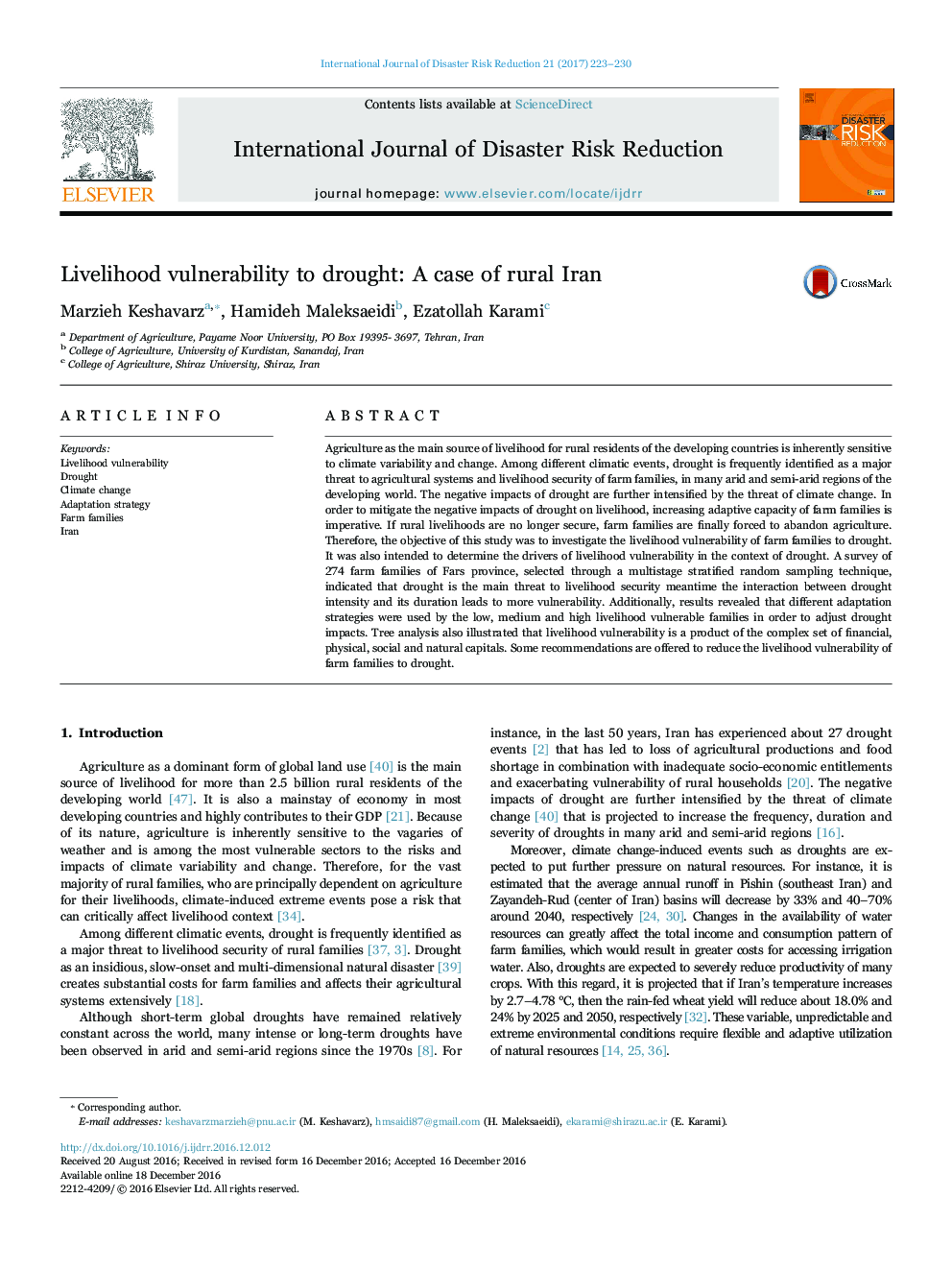| کد مقاله | کد نشریه | سال انتشار | مقاله انگلیسی | نسخه تمام متن |
|---|---|---|---|---|
| 5116179 | 1485149 | 2017 | 8 صفحه PDF | دانلود رایگان |
عنوان انگلیسی مقاله ISI
Livelihood vulnerability to drought: A case of rural Iran
ترجمه فارسی عنوان
آسیب پذیری معیشت به خشکسالی: مورد روستایی ایران
دانلود مقاله + سفارش ترجمه
دانلود مقاله ISI انگلیسی
رایگان برای ایرانیان
کلمات کلیدی
آسیب پذیری معیشت، خشکی، تغییر آب و هوا، استراتژی انطباق، خانواده های مزرعه، ایران،
ترجمه چکیده
کشاورزی به عنوان منبع اصلی برای معیشت برای ساکنین روستایی کشورهای در حال توسعه، ذاتا به تغییرات و تغییرات اقلیمی حساس است. در میان رویدادهای مختلف هواشناسی، خشکسالی اغلب به عنوان یک تهدید جدی برای سیستم های کشاورزی و حفاظت از معیشت خانواده های مزرعه ای در بسیاری از مناطق خشک و نیمه خشک جهان در حال توسعه شناخته شده است. اثرات منفی خشکسالی با تهدید تغییرات آب و هوایی بیشتر شده است. به منظور کاهش اثرات منفی خشکسالی بر منابع معیشتی، افزایش ظرفیت سازگاری خانواده های مزرعه ضروری است. اگر معیشت روستایی دیگر امن نباشد، خانواده های مزرعه در نهایت مجبور به ترک کشاورزی می شوند. لذا هدف از این مطالعه بررسی آسیب پذیری معیشت خانواده های مزرعه به خشکسالی بود. همچنین در نظر گرفته شده بود تا رانندگان آسیب پذیری معیشت را در زمینه خشکسالی تعیین کند. بررسی 274 خانواده مزرعه استان فارس که از طریق روش نمونه گیری تصادفی طبقه بندی شده چند مرحله ای انتخاب شده اند، نشان می دهد که خشکسالی تهدید اصلی برای حفاظت از معیشت است و در عین حال تعامل میان شدت خشکسالی و مدت زمان آن به آسیب پذیری بیشتر می انجامد. علاوه بر این، نتایج نشان داد که استراتژی های انطباق متفاوت برای خانواده های کم درآمد، متوسط و بالا در معرض خطر برای استفاده از تاثیرات خشکسالی استفاده می شود. تجزیه و تحلیل درخت همچنین نشان داد که آسیب پذیری معیشت محصول مجموعه ای از سرمایه های مالی، فیزیکی، اجتماعی و طبیعی است. برخی از توصیه ها برای کاهش آسیب پذیری معیشت خانواده های مزرعه به خشکسالی ارائه شده است.
موضوعات مرتبط
مهندسی و علوم پایه
علوم زمین و سیارات
فیزیک زمین (ژئو فیزیک)
چکیده انگلیسی
Agriculture as the main source of livelihood for rural residents of the developing countries is inherently sensitive to climate variability and change. Among different climatic events, drought is frequently identified as a major threat to agricultural systems and livelihood security of farm families, in many arid and semi-arid regions of the developing world. The negative impacts of drought are further intensified by the threat of climate change. In order to mitigate the negative impacts of drought on livelihood, increasing adaptive capacity of farm families is imperative. If rural livelihoods are no longer secure, farm families are finally forced to abandon agriculture. Therefore, the objective of this study was to investigate the livelihood vulnerability of farm families to drought. It was also intended to determine the drivers of livelihood vulnerability in the context of drought. A survey of 274 farm families of Fars province, selected through a multistage stratified random sampling technique, indicated that drought is the main threat to livelihood security meantime the interaction between drought intensity and its duration leads to more vulnerability. Additionally, results revealed that different adaptation strategies were used by the low, medium and high livelihood vulnerable families in order to adjust drought impacts. Tree analysis also illustrated that livelihood vulnerability is a product of the complex set of financial, physical, social and natural capitals. Some recommendations are offered to reduce the livelihood vulnerability of farm families to drought.
ناشر
Database: Elsevier - ScienceDirect (ساینس دایرکت)
Journal: International Journal of Disaster Risk Reduction - Volume 21, March 2017, Pages 223-230
Journal: International Journal of Disaster Risk Reduction - Volume 21, March 2017, Pages 223-230
نویسندگان
Marzieh Keshavarz, Hamideh Maleksaeidi, Ezatollah Karami,
